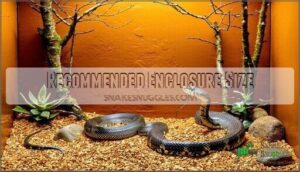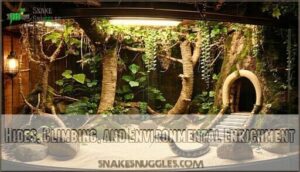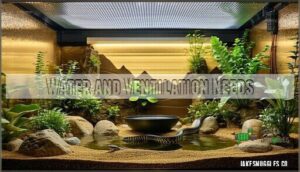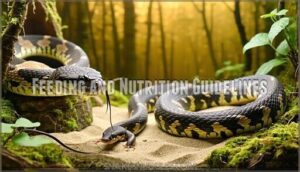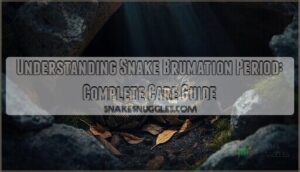This site is supported by our readers. We may earn a commission, at no cost to you, if you purchase through links.
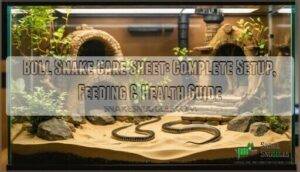 The bull snake’s defensive display rivals a rattlesnake’s—tail vibrating, body coiled, hissing loud enough to hear across a room—yet it’s completely harmless to humans. This theatrical bluff earns Pituophis catenifer sayi both respect and misunderstanding among reptile keepers.
The bull snake’s defensive display rivals a rattlesnake’s—tail vibrating, body coiled, hissing loud enough to hear across a room—yet it’s completely harmless to humans. This theatrical bluff earns Pituophis catenifer sayi both respect and misunderstanding among reptile keepers.
While their impressive size and bold temperament might intimidate beginners, bull snakes adapt remarkably well to captivity when their specific requirements are met. These powerful constrictors need more than a basic setup; their burrowing instincts, temperature preferences, and feeding behaviors demand attention to detail that separates thriving specimens from stressed ones.
Understanding their natural history transforms aggressive hatchlings into manageable adults, while proper husbandry prevents the respiratory infections and behavioral issues that plague inadequately housed individuals.
Table Of Contents
- Key Takeaways
- Bull Snake Natural History and Traits
- Optimal Enclosure and Habitat Setup
- Temperature, Lighting, and Humidity Essentials
- Feeding and Nutrition Guidelines
- Health, Handling, and Behavioral Management
- Frequently Asked Questions (FAQs)
- How often should I clean my bullsnake’s enclosure?
- What temperature range is ideal for a bullsnake’s enclosure?
- Can bullsnakes be housed in plastic shoe boxes?
- How often should I feed my adult bullsnake?
- What substrate is best for a bullsnake’s enclosure?
- What are common health problems in bull snakes?
- How much does a bull snake cost?
- Can bull snakes be housed together safely?
- Do bull snakes need veterinary checkups regularly?
- What are signs of stress in bull snakes?
- Conclusion
Key Takeaways
- Bull snakes require spacious enclosures (minimum 4×2 feet for adults) with proper thermal gradients (88-92°F basking, 75-78°F cool zone) and substrate depth of 2-3 inches to support their natural burrowing behavior and thermoregulation needs.
- Their infamous defensive displays—hissing, tail vibration, and rattlesnake mimicry—are pure bluff that transforms into manageable temperament through consistent, non-feeding interaction using tools like hemostats to prevent hand-prey association.
- Feeding protocols must match life stage precisely: juveniles need appropriately sized prey every 4-5 days to fuel rapid growth, while adults thrive on weekly feedings with careful body condition monitoring to prevent obesity-related organ damage.
- Daily spot-cleaning, monthly complete sanitation, and annual veterinary fecal screenings form the preventive foundation against respiratory infections, scale rot, and parasitic disease that compromise captive bull snake longevity.
Bull Snake Natural History and Traits
Before you bring a bull snake into your home, you’ll want to understand what makes these impressive constrictors tick. Their natural history shapes everything from their temperament to their care requirements, so let’s look at where they come from and what you can expect.
Here’s what sets bull snakes apart as captives.
Geographic Range and Habitat
Bull snakes roam an impressive swath of central North America—from the prairie provinces of Canada all the way south to Mexico, and stretching east-west from Montana clear across to Indiana—making them one of the most geographically adaptable constrictors on the continent.
This geographic distribution means you’ll find them thriving in diverse habitats: arid desert landscapes, sprawling prairie grasslands, deciduous woodlands, and even mountain ecosystems up to moderate elevations.
Their exceptional adaptability to regional variations in climate and terrain directly influences the enclosure and terrarium setup you’ll need to replicate for ideal bullsnake health in captivity.
Physical Description and Color Variations
Beyond geography, you’ll notice striking variations in bullsnake morphology and coloration that make identification both challenging and fascinating. Adult bullsnakes showcase a sturdy, heavy-bodied structure averaging 4–6 feet, though rare specimens approach 8 feet.
Their diagnostic features include:
- Enlarged rostral scales protruding from the snout—taller than wide—perfectly adapted for burrowing
- Base coloration spanning yellow, beige, cream, or light brown with 33–66 large dorsal blotches in brown, black, or reddish tones
- Scale patterns at midbody typically displaying 27–37 rows (commonly 29–33), with smooth texture creating a characteristic sheen
- Color morphs ranging from wild-type patterns to captive-bred albino, leucistic, axanthic, hypo, patternless, and snow variations
Hatchlings emerge gray and shift to adult coloration after their first shed, with males typically reaching larger maximum sizes than females.
Bullsnakes are often found in open habitats that provide them with the necessary conditions for survival.
Behavior Patterns and Activity Cycles
Understanding bullsnake biology and psychology reveals fascinating patterns you’ll need to accommodate. These snakes demonstrate classic diurnal activity during spring and fall, actively foraging in open habitats when temperatures permit peak thermoregulation. During peak summer heat, they shift to nocturnal behavior, hunting after sunset to avoid thermal stress.
You’ll observe migration patterns between feeding grounds and preferred burrow sites—sometimes traveling considerable distances for ecdysis (shedding cycles) that trigger 5–16 day inactivity periods. Their famous defensive displays include tail vibration, loud hissing through specialized glottal structures, and rattlesnake mimicry—pure bluff designed to deter threats without actual aggression.
To guarantee proper care, it’s vital to research their natural habitat needs and replicate these conditions in captivity.
Suitability as Pets
While their sturdy theatrics might suggest otherwise, bullsnakes make remarkably rewarding captives for keepers who understand that initial fire often mellows into manageable companionship with consistent, knowledgeable management. However, their sturdy size, ferocious appetite, and juvenile hyperactivity mean they’re not beginner-appropriate reptiles—you’ll need experience reading serpent body language and confidence managing defensive strikes during acclimation periods.
Critical pet owner qualities for bullsnake success:
- Physical capability to safely manage 5–7 foot constrictors exhibiting defensive strikes during early socialization
- Patience and consistency to transform nervous juveniles into manageable adults through regular, non-feeding interaction
- Financial commitment to provide spacious enclosures, proper heating gradients, and decades of quality rodent prey
Optimal Enclosure and Habitat Setup
Your bull snake’s enclosure isn’t just a box—it’s the foundation of its physical and psychological well-being. Getting the housing right from the start prevents stress-related health issues and promotes natural behaviors that keep your snake thriving.
Let’s break down the essential components you’ll need to create an ideal habitat.
Recommended Enclosure Size
Your adult bull snake will thrive in a 4×2-foot enclosure. Anything smaller than this standard will compromise both their physical health and psychological well-being as these powerful constrictors reach their mature length of five to seven feet.
This cage volume provides adequate space requirements for thermoregulation, exercise, and natural behaviors. You’ll want enclosure dimensions with sufficient habitat depth—at least 18 to 24 inches vertically—to accommodate climbing branches and maintain proper ventilation needs throughout your reptile enclosures and housing system.
Substrate and Furnishing Choices
Substrate Options in your vivarium directly impact your bull snake’s physiological health and behavioral repertoire. Aspen bedding, cypress mulch, and coconut coir (ReptiChip) support natural burrowing while maintaining enclosure humidity between 40–50% during shedding cycles.
These Burrowing Materials retain moisture far more effectively than newspaper, reducing stress hormones and promoting complete sheds. Layer substrate at least two to three inches deep, integrating stable water bowls and reptile-safe furnishings to enable Snake Enrichment through scent trailing and thermoregulation across your terrarium habitat.
Hides, Climbing, and Environmental Enrichment
Proper hides function as stress-reduction architecture, directly lowering cortisol levels and preventing the immune suppression that predisposes captive serpents to respiratory infections and scale rot. Position Hide Box Options at both thermal zones—your bull snake will shuttle between them based on thermoregulatory need. Add branches or cork bark as Climbing Structures to encourage Snake Agility and muscular conditioning, replicating the vertical exploration observed in wild populations.
Environmental Enrichment for Snakes that transforms your Vivarium Setup:
- Visual Barriers like strategically placed rocks reduce perceived threats and normalize feeding responses
- Textured surfaces (cork rounds, slate tiles) enable complete sheds and scale health
- Rotated Environmental Toys like hollow logs stimulate scent-tracking behaviors every cleaning cycle
- Multiple Climbing Opportunities promote cardiovascular fitness and prevent obesity-related organ compression
Water and Ventilation Needs
Fresh water fulfills dual physiological functions in captive bull snakes—it’s both a hydration source and a humidity regulator that directly impacts renal function and respiratory membrane integrity. Use a heavy-based water bowl that won’t tip during nocturnal soaking behaviors, replacing it daily to maintain water quality.
Your ventilation systems must balance air exchange with moisture levels—screen tops paired with a proper temperature gradient prevent stagnant air while maintaining the 30-40% humidity control essential for respiratory health in your enclosure size.
Temperature, Lighting, and Humidity Essentials
Getting your bull snake’s environmental parameters right isn’t optional—it’s the foundation of everything from appetite to immune function. These snakes are remarkably adaptable in the wild, but captivity requires you to deliberately recreate the thermal zones and atmospheric conditions their physiology depends on.
Let’s break down the specific requirements that’ll keep your bull snake thriving year-round.
Creating a Temperature Gradient
Like reptiles across the spectrum, bull snakes operate as ectothermic organisms—meaning they can’t generate their own body heat and instead depend entirely on external thermal zones to regulate metabolism, digestion, immune function, and every physiological process that keeps them thriving.
Bull snakes are ectothermic organisms that depend entirely on external heat sources to regulate every vital physiological process
You’ll need to establish a proper temperature gradient within the enclosure: position heat sources at one end to create a basking zone around 85-90°F, while the opposite end remains cooler at 75-80°F. This gradient control allows your snake to thermoregulate by moving between thermal zones as needed. Always use a reliable thermostat to prevent overheating, and employ multiple thermometers for accurate temperature monitoring across the entire temperature range.
Ideal Humidity Levels and Shedding Support
Bull snakes thrive in environments with relatively low ambient humidity—usually 30-40% under normal conditions. This drier air mimics their native prairies and plains. However, during the shedding process, you’ll need to temporarily boost moisture levels to 40-50% to guarantee complete, healthy skin removal.
Support your Bullsnake’s shed cycle with:
- A humid hide box filled with damp sphagnum moss positioned in the enclosure’s thermal gradient
- Rough surfaces like branches or textured rocks that allow physical assistance with sloughing off old skin
- Close monitoring for milky-blue eyes, signaling the onset of ecdysis and your cue to increase Environmental Balance through targeted Moisture Management
Proper Humidity Control during this vulnerable period prevents retained eye caps and incomplete sheds that compromise Skin Health.
UV Lighting and Photoperiod Management
While humidity and shedding cycles demand your careful attention, lighting orchestrates your bull snake’s daily rhythms and long-term physiological health through carefully managed photoperiods. Install UV lighting on programmable timers to replicate natural Light Cycle patterns—12 hours on, 12 hours off works well year-round.
Though debate continues regarding UVB Dosage necessity for snakes, a low-output UVB lamp aids vitamin D3 synthesis and proper Spectrum Management.
Photoperiod Effects extend beyond simple day-night regulation, influencing appetite, breeding readiness, and metabolic function alongside your established temperature gradient.
Monitoring and Adjusting Environmental Conditions
Your vigilance doesn’t stop once you’ve dialed in the thermostat and hung the UV fixture—environmental parameters drift, equipment fails, and your snake’s responses tell you what the gauges sometimes can’t. Implement these critical Environmental Monitoring practices for peak Temperature Control and Climate Adjustment in your vivarium:
- Digital thermometer/hygrometer combos at both ends track your temperature gradient and Humidity Levels precisely
- Weekly spot-checks with infrared thermometers catch surface temperature discrepancies before metabolic stress develops
- Behavioral cues—excessive soaking, restless cruising, or appetite changes—signal environmental enrichment needs
- Monthly bulb replacements and timer verifications prevent Lighting Cycles from degrading unnoticed
Feeding and Nutrition Guidelines
A bullsnake’s hearty appetite demands careful attention to prey selection, portion control, and feeding frequency throughout its life. Getting nutrition right isn’t just about keeping your snake fed—it’s about supporting healthy growth, preventing obesity, and establishing safe feeding routines that reduce stress for both you and your snake.
Let’s break down the essentials of feeding your bullsnake properly.
Appropriate Prey Types and Sizing
Frozen-thawed rodents—mice and rats—represent the benchmark for captive bullsnake nutrition. Match prey size to your snake’s midsection diameter: hatchlings require pinky mice (2–3 grams), juveniles progress to fuzzies or hoppers (3–8 grams), and adults thrive on adult mice (25–35 grams) or small rats (50–80 grams).
Oversized prey increases regurgitation risk by 15–30%, while live prey can injure your snake. Pre-killed options guarantee safety without compromising dietary variety or nutrient requirements essential for snake care.
Feeding Schedules for Juveniles and Adults
Establishing a feeding rhythm based on your snake’s age and metabolic demands prevents nutritional deficiencies and bolsters steady, sustainable growth through each developmental stage.
Juvenile bullsnakes (under 18 months) require feeding every 4–5 days—offering two to three appropriately sized prey items per meal—to fuel rapid skeletal and muscular development.
Adults shift to weekly feedings of one to two prey items, maintaining nutrient balance without triggering excessive weight gain that compromises long-term health.
Preventing Obesity and Promoting Healthy Growth
Monitoring body condition scores throughout your bullsnake’s life—by palpating vertebral definition and observing waistline taper—enables you to adjust feeding volumes before metabolic imbalances compromise cardiovascular and hepatic function.
Nutrition planning and diet optimization hinge on responsive weight management: if vertebrae disappear beneath adipose tissue, extend intervals between feedings and reduce prey size. Conversely, prominent skeletal landmarks signal the need for increased caloric intake.
Consistent growth monitoring ensures your bullsnake thrives without the burden of obesity-related disease.
Safe Feeding Practices and Tools
Pre-kill freezing eliminates parasites and pathogens, but thawing prey to room temperature—and presenting it with hemostats rather than bare fingers—prevents defensive strikes that mistake your hand for the meal. Following snake feeding guidelines protects both caretaker and snake while reinforcing healthy feeding response patterns.
Here are key practices to follow:
- Feeding tongs or hemostats – Present prey items at a safe distance to avoid bite confusion
- Snake hooks – Use before feeding to signal non-food interaction and reduce aggression
- Proper food storage – Freeze rodents at -20°C for pathogen control; label by size and date
- Consistent feeding frequency – Establish predictable schedules supporting diet and nutrition for snakes
Health, Handling, and Behavioral Management
Your bull snake’s long-term health depends on understanding its behavior and maintaining proper care routines. Many behavioral issues stem from inadequate interaction protocols or environmental stressors that you can address with the right approach.
Let’s walk through the essential management practices that’ll keep your bull snake healthy, calm, and thriving in captivity.
Recognizing and Reducing Aggression
Aggression in bullsnakes isn’t a character flaw—it’s often a learned response to inconsistent management and the snake’s misguided belief that your approaching hand signals mealtime rather than interaction.
Recognizing aggression triggers like feeding schedules and stress reduction through regular, non-food-associated contact helps reshape temperament.
Using a hemostat to present prey items breaks the behavioral association between your hand and food, while observing defensive postures—hissing, coiling, or striking—provides critical behavioral cues that guide your taming methods and management techniques for improved bullsnake behavior.
Handling Frequency and Taming Techniques
Taming a defensive bullsnake requires the same patience you’d invest in earning the trust of any wild creature—short, predictable sessions that build confidence without overwhelming their nervous system.
Interact with your snake three to four times weekly using gentle touch and calming techniques that respect its temperament, gradually extending sessions as snake trust develops through consistent, non-threatening interactions that reshape bullsnake behavior and interaction responses.
Routine Cleaning and Cage Maintenance
A spotless enclosure isn’t just aesthetically pleasing—it’s your first line of defense against respiratory infections, scale rot, and the parasitic invaders that thrive in neglected substrates.
Spot-clean waste daily using tongs or gloved hands, perform partial substrate changes biweekly, and execute complete cage sanitation monthly with reptile-safe disinfectants.
Rinse all surfaces thoroughly—chemical residues compromise respiratory function—and verify enclosures dry completely before reintroducing your snake to prevent humidity spikes that invite bacterial overgrowth.
Monitoring Health and Addressing Common Issues
Your bull snake’s well-being hinges on daily vigilance—lethargy, open-mouth breathing, or oral swelling signal emergencies demanding immediate veterinary care.
Schedule annual health checks with fecal parasite screening, maintain digital logs of feeding schedules and weight trends, and quarantine new arrivals for 30–90 days to safeguard your collection.
Early disease prevention through environmental monitoring and proper snake diet adherence ensures peak animal welfare and drastically reduces mortality risk.
Frequently Asked Questions (FAQs)
How often should I clean my bullsnake’s enclosure?
You’ll want to spot-clean your bullsnake’s enclosure daily to remove feces and soiled substrate, which is critical for preventing bacterial growth and maintaining ideal snake health.
Complete substrate changes and thorough habitat sanitation should occur every four to six weeks.
What temperature range is ideal for a bullsnake’s enclosure?
Your bullsnake thrives when basking sites reach 88–92°F while cooler zones stay around 75–78°F—this thermal gradient lets your snake self-regulate beautifully.
Use heat mats or overhead warming to create these ambient temperatures and lighting cycles.
Can bullsnakes be housed in plastic shoe boxes?
While juveniles may temporarily tolerate plastic containers, adult bullsnakes require spacious vivariums—at minimum 4×2 feet—with proper ventilation needs, humidity control, and enrichment.
Shoebox enclosures severely limit natural behaviors, increase escape attempts, and compromise your snake’s long-term welfare.
How often should I feed my adult bullsnake?
Feed your adult bullsnake one or two appropriately sized mice or a smaller rat once weekly.
This feeding frequency maintains healthy body condition while preventing obesity, allowing adequate time for complete digestion between meals.
What substrate is best for a bullsnake’s enclosure?
Shredded aspen shavings stand out as your best substrate choice for bullsnake enclosures. They’re cost-effective, simple to spot-clean, and maintain appropriate humidity levels while supporting natural burrowing behavior without posing ingestion risks.
What are common health problems in bull snakes?
Regarding maintaining your bullsnake in prime condition, an ounce of prevention is worth a pound of cure. Respiratory issues, skin infections, metabolic disorders, and parasites represent the most common health challenges you’ll encounter, making routine veterinary care and proactive monitoring essential for excellent reptile health and animal welfare.
How much does a bull snake cost?
You’ll spend between $100 and $300 for a captive-bred bullsnake from reputable breeders, though morphs command premium prices.
Ongoing expenses for substrate, prey items, utilities, and veterinary care usually run $30 to $60 monthly throughout your snake’s 15- to 20-year lifespan in captivity.
Can bull snakes be housed together safely?
No—housing multiple snakes together invites territorial aggression, feeding competition, stress-related illness, and potential cannibalism. Bullsnakes thrive as solitary animals in captivity.
Individual enclosures guarantee safety, proper management routines, and allow you to monitor each snake’s health and behavior accurately.
Do bull snakes need veterinary checkups regularly?
Yes, annual veterinary checkups are strongly recommended for your bullsnake. A reptile-specialized veterinarian can detect parasites, respiratory infections, or metabolic issues before clinical signs appear—preventive measures that safeguard long-term animal welfare and enhance snake health through proactive medical care.
What are signs of stress in bull snakes?
When your Bullsnake presses its nose repeatedly against enclosure glass, refuses food for multiple cycles, or suddenly becomes defensive during routine interactions, you’re witnessing physiological stress responses that demand immediate environmental assessment and modification.
Conclusion
Think of your bull snake as a frontier settler—thriving demands more than good intentions; it requires understanding the landscape. When you respect their territorial nature, provide proper thermal zones, and recognize defensive displays as communication rather than aggression, you’re building trust through competent stewardship.
This bull snake care sheet furnishes you with the clinical precision needed to prevent health issues before they surface. Master these fundamentals, and that hissing hatchling transforms into a sturdy, manageable ambassador for one of North America’s most misunderstood constrictors.
- https://community.morphmarket.com/t/bull-snake-cage-size/40700
- https://sites.google.com/site/rudgereptileevents/care-sheets/pine-bull-snake
- https://surreyreptilecentre.co.uk/wp-content/uploads/2022/04/Bull-Snake-Care-Sheet.pdf
- http://www.kingsnake.com/pituophis/care_group1.html
- https://mdc.mo.gov/discover-nature/field-guide/bullsnake

